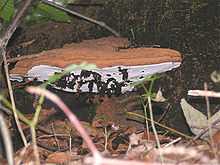Ganoderma applanatum
| Ganoderma applanatum | |
|---|---|
 | |
| Scientific classification | |
| Kingdom: | Fungi |
| Division: | Basidiomycota |
| Class: | Agaricomycetes |
| Order: | Polyporales |
| Family: | Ganodermataceae |
| Genus: | Ganoderma |
| Species: | G. applanatum |
| Binomial name | |
| Ganoderma applanatum (Pers.) Pat. | |
| Synonyms | |
| |
Ganoderma applanatum (Artist's Bracket, Artist's Conk, or Flacher Lackporling; syn. ) is a bracket fungus with a cosmopolitan distribution.
The spore bodies are up to 30–40 centimetres (12–16 in) across, hard, woody-textured, and inedible; they are white at first but soon turn dark red-brown.
It is a wood-decay fungus, using primarily dead heartwood, but also as a pathogen on live sapwood, particularly on older trees. It is a common cause of decay and death of beech and poplar, and less often of several other tree genera, including alder, apple, elm, buckeye and horse chestnut, maple, oak, walnut, willow, western hemlock, Douglas Fir, and Spruce.
A peculiarity of this fungus lies in its ability to be as a drawing medium for artists. When the surface is rubbed or scratched with a sharp implement, it changes from light to dark brown, producing visible lines and shading.
The Anne Frank tree in Amsterdam suffered rot from Ganoderma applanatum before it blew over in 2010.
Fungivory

The midge, Agathomyia wankowiczii (Platypezidae) lays its eggs on the fruiting body of the fungus forming galls.[1]
| Ganoderma applanatum | |
|---|---|
|
| |
| pores on hymenium | |
| no distinct cap | |
| hymenium is decurrent | |
| lacks a stipe | |
| spore print is brown | |
| ecology is parasitic | |
| edibility: inedible | |
See also
- Forest pathology
- Medicinal mushrooms
References
- Phillips, D. H., & Burdekin, D. A. (1992). Diseases of Forest and Ornamental Trees. Macmillan.
- Ganoderma applanatum
- Ganoderma applanatum
- Photographs of the fungus, including one used as a drawing surface
- Several drawings created on these fungi
External links
 Media related to Ganoderma applanatum at Wikimedia Commons
Media related to Ganoderma applanatum at Wikimedia Commons- Observations on Mushroom Observer